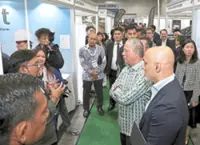They may not exactly be mainstream but there are already some solutions on the market for generating one's own electricity at home. — AFP Relaxnews
In 2023, the technology for us to manage our own electricity, whether by producing it, storing it or both at the same time, will be within reach – at least in theory. Currently, the technology exists not only for individual households to produce their own electricity, but also to store it and be able to use it when needed.
Faced with rising energy prices and the risk of shortages, more and more households are taking the plunge and creating their own electricity reserves, even if these solutions are still far from enabling total energy self-sufficiency. We take a look at the latest developments – and the challenges – of the phenomenon in France in our After Calendar, our trend book for 2023.
Already a subscriber? Log in
Save 30% OFF The Star Digital Access
Cancel anytime. Ad-free. Unlimited access with perks.





